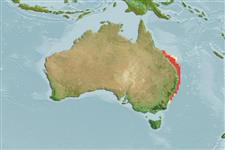Environment: milieu / climate zone / depth range / distribution range
Ecologie
marien rifbewoner; diepte 27 - 80 m (Ref. 5222). Temperate; 20°S - 36°S, 135°E - 156°E (Ref. 5222)
Western Pacific: endemic to Australia, from southern Queensland (One Tree Islands, Great Barrier Reef at 23°30'S) to Bateman's Bay (35°44'S), New South Wales. One specimen was reported from Kangaroo Islands, South Australia.
Grootte / Gewicht / Leeftijd
Maturity: Lm ? range ? - ? cm
Max length : 61.0 cm TL mannelijk / geslacht onbekend; (Ref. 5222); max. gepubliceerd gewicht: 5.5 kg (Ref. 4787)
Dorsale stekels (totaal): 11; Dorsale zachte stralen (totaal): 15-17; Anale stekels 3; Anale zachte stralen: 8. Interorbital area convex, Almost straight dorsal profile; preopercle sub angular, serrae slightly enlarged; upper edge of the operculum almost straight; nostrils subequal; maxilla reaches to or slightly beyond vertical at posterior edge of the eye. Pectoral fins fleshy; pelvic fins not reaching anus, except in small individuals. Pyloric caeca 11. Characterized further by the following: buff body, covered with close-set wavy longitudinal brownish orange, golden brown or reddish brown stripes; some stripes broken into series of small spots; pale greyish brown head, covered with small spots same as on the body; orange-brown maxillary streak; pale fin rays, with small brown spots, inter-radial membranes dark brown; narrow yellow margins on median fins; pectoral fins diffusely yellow distally (Ref. 89707).
Inhabits coral reefs (Ref. 58652) and rocky areas. It is an active swimmer that will leave the bottom to take a floating bait.
Levenscyclus en paargedrag
Maturiteit | Voortplanting | Paaien | Eieren | Fecunditeit | Larven
Heemstra, P.C. and J.E. Randall, 1993. FAO Species Catalogue. Vol. 16. Groupers of the world (family Serranidae, subfamily Epinephelinae). An annotated and illustrated catalogue of the grouper, rockcod, hind, coral grouper and lyretail species known to date. Rome: FAO. FAO Fish. Synop. 125(16):382 p. (Ref. 5222)
Status op de Rode Lijst van het IUCN (Ref. 130435)
Gevaar voor de mens
Harmless
Gebruik door de mens
Visserij: commercieel
Meer informatie
Lokale namenSynoniemenMetabolismePredatorenEcotoxicologieVoortplantingMaturiteitPaaienPaaiaggregatiesFecunditeitEierenOntwikkeling van de eieren
ReferentiesAquacultuurAquacultuurprofielKweeklijnenGeneticaElectrophoresesErfelijkheidZiektesVerwerkingNutrientsMassaconversie
Tools
Speciale rapporten
Download XML
Internetbronnen
Estimates based on models
Preferred temperature (Ref.
123201): 21.1 - 25.1, mean 24.4 °C (based on 14 cells).
Fylogenetische diversiteitsindex (Ref.
82804): PD
50 = 0.5000 [Uniqueness, from 0.5 = low to 2.0 = high].
Bayesian length-weight: a=0.01175 (0.00571 - 0.02419), b=3.04 (2.88 - 3.20), in cm total length, based on LWR estimates for this Genus-body shape (Ref.
93245).
Trofisch niveau (Ref.
69278): 3.9 ±0.5 se; based on size and trophs of closest relatives
Weerstandsvermogen (Ref.
120179): Gemiddeld, minimale populatieverdubbelingstijd 1,4-4,4 jaar (Preliminary K or Fecundity.).
Fishing Vulnerability (Ref.
59153): Moderate vulnerability (44 of 100).
Nutrients (Ref.
124155): Calcium = 8.02 [2.94, 18.42] mg/100g; Iron = 0.161 [0.081, 0.370] mg/100g; Protein = 18.8 [17.2, 20.3] %; Omega3 = 0.316 [0.164, 0.585] g/100g; Selenium = 8.56 [3.88, 18.88] μg/100g; VitaminA = 117 [25, 535] μg/100g; Zinc = 0.611 [0.387, 0.943] mg/100g (wet weight);
